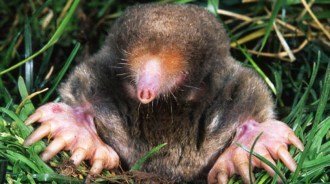
Senior writer Tina Hesman Saey is a geneticist-turned-science writer who covers all things microscopic and a few too big to be viewed under a microscope. She is an honors graduate of the University of Nebraska-Lincoln where she did research on tobacco plants and ethanol-producing bacteria. She spent a year as a Fulbright scholar at the Georg-August University in Göttingen, Germany, studying microbiology and traveling. Her work on how yeast turn on and off one gene earned her a Ph.D. in molecular genetics at Washington University in St. Louis. Tina then rounded out her degree collection with a master’s in science journalism from Boston University. She interned at the Dallas Morning News and Science News before returning to St. Louis to cover biotechnology, genetics and medical science for the St. Louis Post-Dispatch. After a seven year stint as a newspaper reporter, she returned to Science News. Her work has been honored by the National Academies of Sciences, Engineering and Medicine, the Endocrine Society, the Genetics Society of America and by journalism organizations.

Trustworthy journalism comes at a price.
Scientists and journalists share a core belief in questioning, observing and verifying to reach the truth. Science News reports on crucial research and discovery across science disciplines. We need your financial support to make it happen – every contribution makes a difference.
All Stories by Tina Hesman Saey
-

-
 Life
LifeInflammation feeds E. coli
Inflammation, normally a defense against microbes, may become counterproductive in the gut by feeding disease-causing bacteria.
-
 Animals
AnimalsMole sniffs the world in stereo
Nostrils of the common mole recognize slight differences in smells to steer it toward its food.
-
 Life
LifeNerve stem cells treat gut disorder in mice
Nerve stem cell therapy treats gut disorder by connecting to nervous system.
-
 Life
LifePigeons’ prominent plumage traces to one gene
A mutation responsible for ruffs, crests and collars appears to have arisen once and then passed among species through breeding.
-
 Life
LifeGene variant makes flu particularly dangerous
People with one form of IFITM3 are more likely to develop pneumonia.
-
 Humans
HumansH5N1 influenza research moratorium ends
Scientists lift self-imposed moratorium on research that would make avian flu transmissible among humans.
-
 Life
LifeStarchy diet may have transformed wolves to dogs
Gaining the ability to digest carbohydrates may have been an important step in domesticating dogs.
-
 Life
LifeGenes tied to body mass set point
Genes may help determine why some mice (and perhaps people) become obese when eating a sugar- and fat-laden diet.
-
 Life
LifeGenes indicate Stone Age link between India and Australia
Genetic evidence suggests some people migrated from India to Australia roughly 4,300 years ago.
-
 Life
LifeReprieve for reprogrammed stem cells
A study published in 2011 in Nature found that stem cells produced by reprogramming mouse skin cells get attacked when transplanted back into mice.
-
 Life
LifeCorals beat heat by being prepared
Warming waters have little effect on reef-building organisms that activate adaptive genes before the temperature starts to rise.